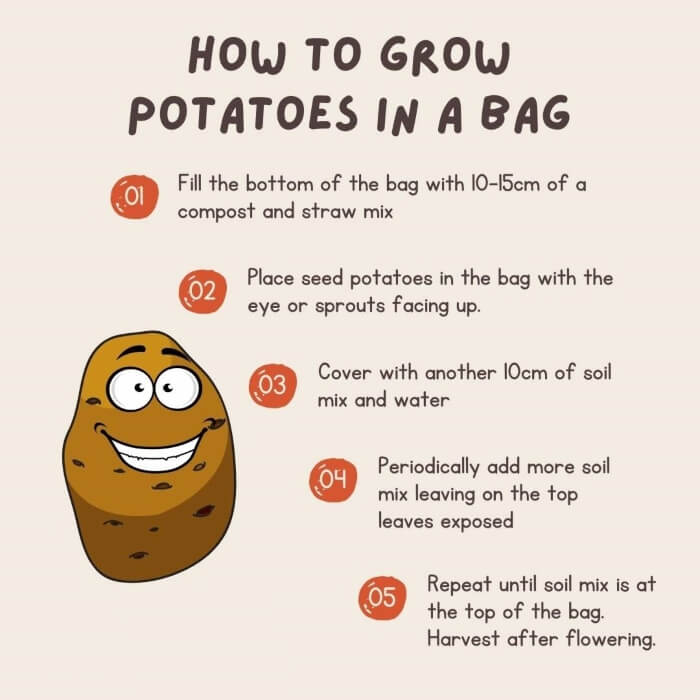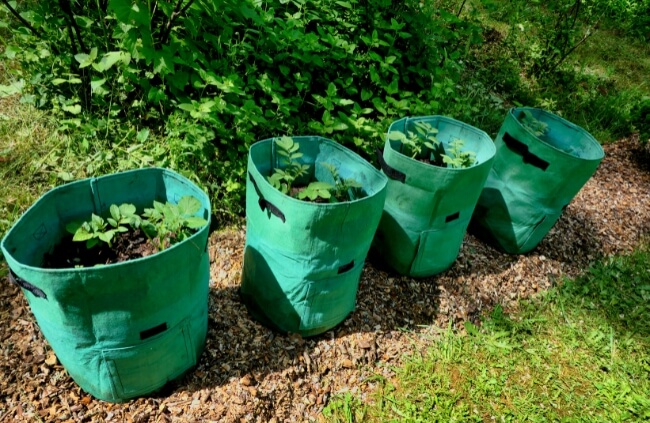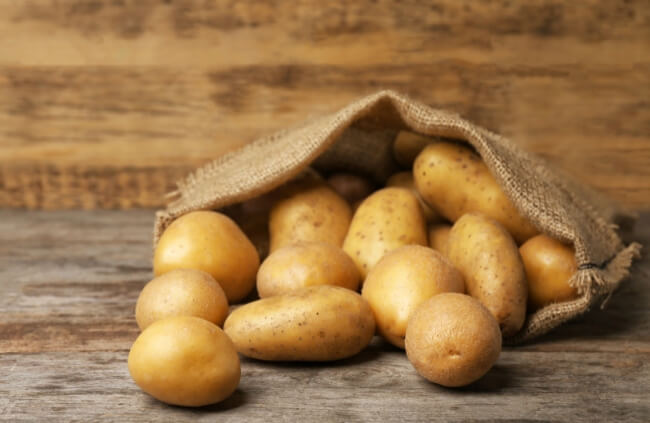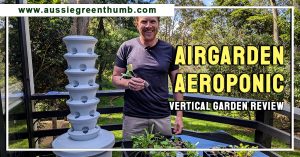There is nothing like the taste of home-grown potatoes. The good news is that they really aren’t that hard to grow. There is no need to worry if you don’t have a veggie patch or room in your garden to plant potatoes.
Potatoes grow well in containers and potato grow bags are the perfect solution for gardeners lacking space or as a fun activity for the kids. This guide will cover everything you need to know about growing spuds in a container. If you’d like to know how to successfully grow potatoes in a bag, read on.
More...
What is a Potato Grow Bag?

A potato grow bag is a durable, breathable bag that allows air to circulate throughout the root system. They provide a fantastic space-saving option to grow seed potatoes or other deep-rooted vegetables.
Potato planter bags that you buy are typically made from hard-wearing polyethylene. They often have a resealable window, for harvesting new potatoes, towards the bottom of the container.
They are normally around 40-50 cm high and 35 cm in diameter. These durable bags can be reused over several years. You can also make your own potato grow bags.
Do Potato Grow Bags Work?
Absolutely. By following the guide below you’ll soon be producing delicious home-grown potatoes. Potatoes do well in containers. You don’t need a large veggie patch to grow them, and they can thrive in potato grow bags.
Traditionally, when growing potatoes in a veggie patch, gardeners ‘hill’ their plants. This involves periodically covering their potato plants with additional fresh soil as they grow. Forming a hill protects the tubers from light and supports the plant.
You’ll be following a similar process in the potato grow bag by adding layers of soil as the plant grows. The more you cover the tubers, the more roots are sent out through the soil mix and the larger the harvest.
How many potatoes can you grow in a grow bag?
Depending on the size of your container and the size of the seed potatoes, a potato planter bag will normally hold about 3-5 seed potatoes. Don’t be tempted to add more because they will be competing for nutrients, and you’ll end up with a similar or worse harvest.
Again, depending on the variety of potatoes planted and when you harvest them, you should expect about 2-3 kgs of spuds per seed potato planted.
When to Plant Potatoes in Grow Bags?
The best time to plant potato grow bags in Australia is in late winter. They are a warm-season plant, so you will want to make sure that the chance of frost has passed. Planting around August is ideal in most temperate regions of Australia.
Potatoes prefer mild conditions and between 16°C and 22°C is the perfect temperature. In frost-free tropical and subtropical parts of Australia, potatoes can be planted and grown all year round. It is best though to avoid the wet season.
What to Plant in Potato Grow Bags?
You will want to plant seed potatoes. These are grown with the specific purpose of being replanted to produce a crop of potatoes. They sort of look like a potato but there are two key differences to the ones you buy at the grocery store.
Firstly, they won’t have been sprayed with sprout inhibitors. Importantly they will also be disease-free. Spuds are prone to soil-borne pests and diseases so buying certified seed potatoes for your grow bag is a must.


Get Your Free Guide:
Master Growing Australian Natives eBook
A Must Have Complete Guide for Every Australian Garden
Get Your Free Guide:
Master Growing Australian Natives eBook
A Must Have Complete Guide for Every Australian Garden
It is a good idea to let your seed potatoes sprout first before planting. Allowing your seed potatoes to grow shoots before you plant them is called ‘chitting’. Plant the seed potatoes with the eyes facing up.
How to Grow Potatoes in a Bag

Planting and growing potatoes in a bag of soil is easy. The soil mix layering approach is a no-fuss method of growing potatoes in a container. It involves some basic setup and then semi-regular topping up of the soil mixture, as the plant grows, until reaching the top of the grow bag. You can then start harvesting a couple of weeks after the potato plant flowers.
Best Soil for Potatoes in Bags
When using a potato bag, it is important to use good quality soil. Potatoes love rich soil with lots of organic matter. You can use potting mix or compost, although compost will produce better results. The best combination is some fresh compost, well-rotted animal manure and some straw.
While potatoes will adapt to light or heavy soils, good drainage is essential. The soil should be well-draining to prevent the tubers from rotting. Adding the straw will help to ensure you have the necessary water drainage.
Where to Position Your Potato Grow Bags

Potato plants like plenty of sun, although they will tolerate partial shade. Ideally, find a sunny spot in the garden to put your potato grow bag.
How long does it take to grow potatoes in a grow bag?
Your spuds will be ready to harvest a couple of weeks after the plant flowers. Depending on how mature you want your potatoes, they will typically be ready between two and four months after planting.
Caring for Potatoes in a Bag
Potato grow bags are a simple and convenient way to grow spuds. There are still a few growing tips to keep in mind.
Firstly, it is important to ensure that new tubers are kept covered by soil. Reducing light exposure will encourage more tubers to grow. This also protects the new potatoes from being attacked by potato moth caterpillars.
Don’t overwater to avoid the tubers rotting. Watering regularly about once or twice a week, over the lifetime of the plants is best practice and will make sure you grow smooth, well-developed potatoes.
Assuming you have been using rich, organic matter filled soil, there isn’t much need to add additional fertiliser as you go. If using a potting mix and you do want to feed your potatoes, use some blood and bone, dynamic lifter or liquid seaweed fertiliser.
How to Make a DIY Potato Grow Bag
The good news is that potato grow bags are relatively easy to make yourself. It’s also an opportunity to avoid using plastic. A good option for homemade potato bags is to use a hessian / burlap bag or old coffee sack.
Just keep the sides rolled down and unroll as you begin to fill with soil in line with the plant’s growth. With even less effort, you can simply cut the top off a bag of compost dumping out most of the compost and roll the top of the bag down.
Follow the same process as above by planting in the bottom of the bag and then simply add more compost as the plants grow. Simple!
Harvesting from Potato Grow Bags

Harvesting potatoes is great fun. It also makes a great activity for kids. Harvesting potatoes is like a treasure hunt, so get them involved. You can begin to harvest tubers, when they are small, a couple of weeks after the plants begin to flower and the lower leaves are beginning to yellow.
These ‘new potatoes’ should be ready about 2- 3 months after planting. Note that these new potatoes don’t have thick skins and don’t store well. They are delicious to eat though if you cook them straight away.
If you have a panel towards the bottom of the potato grow bag, you’ll be able to stagger the potato harvest, without exposing the entire crop, and enjoy them fresh over a longer period.
The alternative approach is to wait until the plant has died back. This is normally around 4 months after planting. Unlike the small, sweet ‘new’ potatoes which are harvested earlier, this will allow your potatoes to mature and the skin to thicken. These potatoes will be larger and can be stored longer. Store them in a cool, well ventilated, dark place and not in the fridge!
One of the advantages of using a potato grow bag is that you are controlling the area the tubers are planted in, making it easy and simple to harvest. Because the potatoes are contained in the bag all you have to do is dig around to find them.
If you have any additional questions about how to grow potatoes in a bag, get in touch.
Potato Grow Bags Frequently Asked Questions
What is the best bag for growing potatoes?
Potato bags are available in a variety of materials including but not limited to Polyethylene, plastic, woven and nonwoven cloth, and even felt. While each material certainly offers its own set of advantages and disadvantages, the best potato bag should be durable, breathable, and allow for optimal air circulation and soil drainage.
How long do potatoes take to grow in a bag?
While growing conditions can affect the growing time in bags, potatoes grown in bags will typically take around 80 days to mature after planting.
How many potatoes should you put in a grow bag?
Naturally, this would depend on the size of the potato grow bags, but a good general rule of thumb is to give each potato plant roughly 2.5 gallons of space. This should allow for optimal growth of the crop while limiting unwanted competition of nutrients between the plants.
Do potatoes need fertiliser in grow bags?
Fertiliser can be beneficial for potatoes grown in bags depending on the quality of the growing medium. If you’re using a rich and organically enhanced soil, fertiliser may not be necessary.
However, if you’re using perhaps a standard potting mix, then some blood and bone or a liquid seaweed fertiliser can help boost the soil.
When should you harvest potatoes from a grow bag?
If you’re a little unsure if your bag-grown potatoes are ready for harvest, you can gently dig below the soil surface to see how big they are. If they are a little too small, leave them for another week or two then harvest for a larger yield.
How should you prepare soil for a grow bag?
Most vegetables, including potatoes, will grow best in a high-quality, rich, and well-draining soil mix. To prepare for sowing, you can lightly water the soil and add a balanced slow-release fertiliser to provide extra nutrients during the initial growing stage.
Be sure to also fill the bags properly, leaving about five to eight centimetres from the top of the bag.
Where do you put potatoes in a grow bag?
Potato plants thrive in plenty of sunlight, but they can tolerate partial shade. Pick a sunny spot in your landscape to position your potato grow bag.
Do you need to put holes in the bottom of potato grow bags?
Potato plants do require sufficient water to grow but they can’t be waterlogged. That is why it is important to always use quality, free-draining soil. If you find you are struggling with proper soil drainage, you can create a few drainage holes at the bottom of your grow bags to help improve the growing conditions.
Wrapping Up Our Potato Grow Bags Guide
Growing potatoes in a bag is easy, rewarding and the ideal way to grow them if you have limited space. The soil mix layering approach is a no-fuss method involving just a few simple steps.
The contained environment of this potato growing technique means you are unlikely to encounter any soil-borne diseases and you can monitor how the plant develops.
Using a grow bag also takes the effort out of harvesting. It’s great fun and home-grown potatoes taste amazing. Buying a potato grow bag or making your own is a great investment as they can be reused year after year.
Published on August 24, 2023 by Gary Clarke
Last Updated on October 25, 2023




